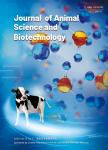Intrauterine growth restriction alters growth performance, plasma hormones,and small intestinal microbial communities in growing-finishing pigs
Intrauterine growth restriction alters growth performance, plasma hormones,and small intestinal microbial communities in growing-finishing pigs作者机构:CAS Key Laboratory of Agro-ecological Processes in Subtropical RegionsHunan Provincial Key Laboratory of Animal Nutritional Physiology and Metabolic ProcessNational Engineering Laboratory for Pollution Control and Waste Utilization in Livestock and Poultry ProductionInstitute of Subtropical AgricultureChinese Academy of SciencesChangsha 410125HunanChina Key Laboratory of Animal Nutrition in Jiangxi ProvinceCollege of Animal Science and TechnologyJiangxi Agricultural UniversityNanchang 440000JiangxiChina UniversitéParis-SaclayAgroParisTechINRAEUMR PNCA75005 ParisFrance.
出 版 物:《Journal of Animal Science and Biotechnology》 (畜牧与生物技术杂志(英文版))
年 卷 期:2021年第12卷第1期
页 面:340-357页
核心收录:
学科分类:0710[理学-生物学] 0831[工学-生物医学工程(可授工学、理学、医学学位)] 0832[工学-食品科学与工程(可授工学、农学学位)] 1004[医学-公共卫生与预防医学(可授医学、理学学位)] 0905[农学-畜牧学] 09[农学] 0906[农学-兽医学] 0703[理学-化学] 0836[工学-生物工程]
基 金:jointly supported by the National Natural Science Foundation of China (31772613 and 31572421) Special Funds for Construction of Innovative Provinces in Hunan Province (2019RS3022)。
主 题:Growing-finishing pigs Growth performance Intrauterine growth restriction Microbial community Small intestine
摘 要:Background: The interaction of the gut microbiota with key metabolic and physiological processes may be associated with poor growth outcomes in animals born with intrauterine growth restriction(IUGR).Results: Growth performance, plasma hormone concentrations, and intestinal microbiota composition were analyzed in IUGR pigs and in normal birth weight(NBW) pigs when the NBW pigs reached 25, 50, and 100 kg of body weight(BW). Compared to NBW pigs, IUGR pigs had lower initial, weaned, and final BW, and lower average daily gain and average daily feed intake in all the considered time points. In the 25 kg BW group, IUGR pigs had higher concentrations of plasma ghrelin and pancreatic polypeptide(PP), but lower insulin concentration than NBW pigs, while the situation was reversed in the 50 kg BW group. As compared to NBW pigs, IUGR pigs had higher microbial alpha diversity in the jejunum and ileum;in the 50 and 100 kg BW groups, IUGR pigs had higher Firmicutes abundance but lower Proteobacteria abundance in the jejunum, and lower Lactobacillus abundance in the jejunum and ileum;in the 25 kg BW group, IUGR pigs showed higher unclassified Ruminococcaceae abundance in the ileum;and in 25 and 50 kg BW groups, IUGR pigs showed lower Ochrobactrum abundance in the jejunum.Spearman s correlation revealed that Lactobacillus was negatively correlated with growth performance, while unclassified Ruminococcaceae was positively correlated. Predictive metagenomic analysis detected significantly different expression of genes in the intestinal microbiota between IUGR and NBW pigs, suggesting different metabolic capabilities between the two groups.Conclusions: Growing-finishing IUGR pigs showed lower growth performance, higher microbial alpha diversity, and differences in plasma hormone concentrations compared to NBW pigs. Alterations in the abundance of Firmicutes,Proteobacteria, Ruminococcaceae, Lactobacillus, and Ochrobactrum in the small intestine may be associated with IUGR, and may therefore serve as a future target for gut microbiota intervention in growing-finishing IUGR pigs.



